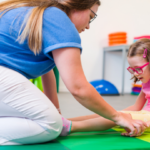Children with cerebral palsy often face challenges with mobility due to muscle spasticity. Foot braces, also known as orthoses, play a significant role in helping these children walk more efficiently and with less pain.
The Role of Foot Braces in Cerebral Palsy
Foot braces, particularly ankle foot orthoses (AFOs), are commonly prescribed for children with cerebral palsy. These braces support the foot and ankle, helping to improve walking patterns and reduce discomfort.
Types of Ankle Foot Orthoses (AFOs)
- Hinged AFOs: These braces allow some movement, providing flexibility while maintaining support.
- Rigid AFOs: These braces keep the foot in a fixed position, which helps in preventing toe walking and maintaining proper alignment.
Benefits of AFOs
- Prevention of Toe Walking: AFOs help keep the foot flat, preventing the child from walking on their toes.
- Improved Foot Control: For diplegic children who tend to be flat-footed, AFOs offer better control and stability.
- Enhanced Walking Efficiency: By providing proper support, AFOs make walking less painful and more efficient.
Selecting the Right Brace
Choosing the right brace involves a comprehensive evaluation by a qualified orthopedist, like Dr. Siambanes, and a certified orthotist. These professionals will assess your child’s specific needs and determine the most suitable type of brace.
Factors Considered in Brace Selection
- Degree of Spasticity: The severity of muscle tightness will influence whether a hinged or rigid brace is recommended.
- Foot and Ankle Alignment: Proper alignment is crucial for effective walking, and the type of brace selected will help maintain this alignment.
- Child’s Activity Level: More active children may benefit from hinged AFOs that allow greater flexibility, while less active children might need rigid AFOs for better support.
- Comfort and Fit: Ensuring that the brace fits well and is comfortable for the child to wear is essential for long-term use.
Wearing and Usage Guidelines
Children typically wear braces for 6-8 hours a day. In some cases, nighttime braces are also recommended to maintain proper alignment while sleeping.
Addressing Concerns About Wearing Braces
Many children feel self-conscious about wearing braces, especially during school hours. It’s important to address these feelings and find solutions that encourage brace use without causing embarrassment.
When Braces Become Intolerable
If a child finds braces uncomfortable or intolerable, other treatments such as casting, Botox injections, or surgery may be necessary to correct alignment issues and prevent further complications.
Importance of Regular Evaluations
Regular evaluations by a qualified orthopedist and orthotist are crucial to ensure the braces are fitting correctly and effectively aiding the child’s mobility. These professionals can make necessary adjustments and provide alternative solutions if needed.
Get Care for Your Child with Cerebral Palsy
Foot braces are a vital part of managing cerebral palsy, offering significant benefits in terms of comfort and mobility. Ensuring that your child receives the proper evaluation and support from healthcare professionals will help them achieve the best possible outcomes.
At Children’s Cerebral Palsy, we are dedicated to providing comprehensive care for children with cerebral palsy. Dr. Siambanes is here to support your child’s journey to improved mobility and a better quality of life through the effective use of foot braces and other treatments. Click here to contact us and schedule an appointment today.






